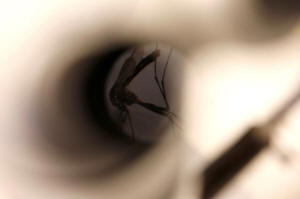|
Doctors devise care plan for babies as
Zika threat looms in U.S.
 Send a link to a friend
Send a link to a friend
 [July 22, 2016]
By Julie Steenhuysen [July 22, 2016]
By Julie Steenhuysen
CHICAGO (Reuters) - As U.S. public health
officials try to determine whether Zika has arrived in the country,
doctors are establishing guidelines on how to care for the rising number
of babies whose mothers were infected with the virus during pregnancy.
Florida said it is investigating two possible cases of Zika not related
to travel to an area where Zika is active, raising the possibility of
the first incidence of local transmission of the mosquito-borne virus.
On Thursday, the Florida Department of Health said it was investigating
a non travel-related case of Zika in Broward County, marking the second
such case. Florida has asked the U.S. Centers for Disease Control and
Prevention to assist in its investigation that must also rule out sexual
transmission.
So far, 400 pregnant women in the continental United States have
evidence of Zika infection, up from 346 from a week ago, the CDC
reported on Thursday. All of those were related to travel or sex with an
infected person who had traveled.
Three more babies have been born in the United States with birth defects
linked to Zika infections in their mothers, bringing the total to 12,
CDC said.
Zika has been proven to cause microcephaly, a severe birth defect marked
by small head size and undersized brains that requires a complex network
of care providers and social workers to treat and provide support to
parents.

But microcephaly is just the tip of the iceberg, according to experts
speaking at a CDC-sponsored workshop on Thursday. They said many babies
exposed in utero who appear normal at birth may have developmental
problems down the road, including hearing and vision problems.
For example, babies born without a functional sucking reflex may never
develop the ability to swallow and will need to be fed through a feeding
tube. These infants will have a higher risk of pneumonia, said Dr. Edwin
Trevathan, a pediatrician and child neurologist at Vanderbilt University
Medical Center.
Less obvious damage to structures on only one side of the brain may
cause seizure disorders that do not appear until adolescence, Trevathan
said.
Pediatric experts at the workshop are reviewing the potential
consequences of Zika infection and plan to make recommendations on ways
to treat Zika-exposed infants.
The connection between Zika and microcephaly first came to light last
fall in Brazil, which has now confirmed more than 1,600 cases of
microcephaly that it considers related to Zika infections in the
mothers.
FLORIDA PROBE
The recommendations come as Florida officials investigate what may be
the first cases of Zika in the continental United States caused by the
bite of a local mosquito.
Florida officials will not elaborate on how a resident of Miami was
infected and whether the first case under investigation was related to
mosquitoes.
[to top of second column] |

A mosquito is seen under a microscope at the Greater Los Angeles
County Vector Control District in Santa Fe Springs, California,
U.S., May 18, 2016. REUTERS/Lucy Nicholson

"We continue to investigate and have not ruled out travel or sexual
transmission at this time," Florida spokeswoman Mara Gambineri said
in an email on Thursday. However, she said the state still suspects
the case is not related to travel to a Zika-infected area.
The White House on Wednesday released a statement saying President
Barack Obama had spoken to Florida Governor Rick Scott regarding a
suspected case of mosquito transmission of Zika and promised more
money to fight the virus.
At the Zika workshop, Dr. Marc Fischer, chief of surveillance and
epidemiology activity at the arboviral diseases branch of the CDC,
said the agency has worked with state health departments to
establish strategies to identify possible local transmission in the
United States.
"When and if there is a case of local transmission, we work with
local health departments to identify additional cases to define the
geographic scope of the outbreak," he said.
That includes surveying households and neighbors within a 150-yard
radius around the residence of the person who has Zika.
"That's basically the flying radius of the vector mosquitoes," he
said.
According to the U.S. Zika response plan, Zika local transmission is
defined as two or more cases not due to travel or sex with an
infected person that occur in a one-mile diameter over the course of
a month.
CDC has given Florida $2 million for Zika preparedness, and on
Thursday awarded another $5.6 million to assist the state with Zika
as part of an additional $60 million in Zika funds to states
announced on Thursday. U.S. lawmakers so far have not approved any
of the White House's $1.9 billion request for Zika.

CDC plans to award another $10 million to states and territories on
Aug. 1 to speed identification of microcephaly and other birth
defects linked to Zika.
(Additional reporting by Bill Berkrot in New York; Editing by
Bernard Orr)
[© 2016 Thomson Reuters. All rights
reserved.]
Copyright 2016 Reuters. All rights reserved. This material may not be published,
broadcast, rewritten or redistributed. |